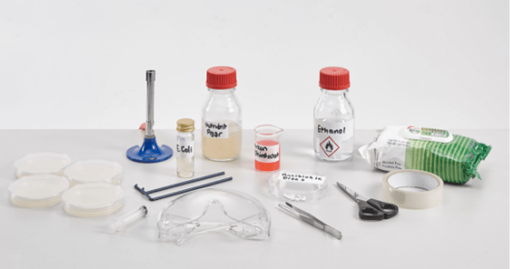
Investigating antibiotic resistance
Investigate the effect of antiseptics or antibiotics on bacterial growth using agar plates and measuring zones of inhibition.
Students are required to prepare a bacterial lawn plate on which to test the effectiveness of antibiotics. Aseptic technique must be followed during this practical and care must always be taken when handling bacterial cultures. Pre-impregnated antibiotic discs could be used as an alternative to students producing their own. If using Penicillin discs of different concentrations, it is recommended that Micrococcus Luteus cultures are used to produce the lawn plate.

Equipment (per pair of participants)
• Bunsen burner
• Safety goggles
• 1 x nutrient agar plate
• 1 x bacterial culture (M. Luteus or E. Coli)
• 1 x sterile L-shaped spreader
• 1 x sterile 1ml syringe
• 1 x permanent marker or chinagraph pencil
• Blank filter paper discs and a selection of antiseptics to test (or pre-impregnated antibiotic discs)
• 1 x discard beaker of Virkon® disinfectant
• 1 x forceps
• 1 x roll of sellotape and scissors to cut
Method
- Students must put on a pair of safety goggles, tying long hair back, and prepare their working area by disinfecting the bench and wiping it dry with paper towels.
- They must set up a Bunsen burner and light the Bunsen, leaving the safety flame on.
- Before handling the agar plate and associated equipment, students must thoroughly wash their hands using anti-bacterial hand wash (not hand sanitizer which may contain alcohol and present a fire hazard).
- They can now collect their equipment, agar plate and bacterial culture and position them close to their Bunsen burner.
- They should now label the underside of the base of a petri dish containing nutrient agar. Around the edge of the base, their name or initials should be written, along with the date, their class (to help the technician to store the plates during incubation) and the name of the bacterial culture that the class are using.
- Students then divide the base into three sections, numbering them 1-3, and place a dot in the middle of each section to show where they are going to place the antiseptic disc.
- The Bunsen burner collar should now be turned so that a blue flame is present.
- Working close to the Bunsen flame, students should unscrew and remove the top from the bacterial culture bottle, keeping the lid in their hand. They then pass the neck of the bottle through the blue Bunsen flame, twisting the bottle as they go. Then using a 1ml syringe, collect 1ml of bacterial culture.
- The flaming of the culture bottle neck is then repeated, and the lid is replaced. The bottle can now be put down on the bench close to the Bunsen burner.
- Students should gently lift the lid of their nutrient agar plate slightly and syringe the 1ml of bacteria onto the surface of the plate and close the lid. Their used syringe should be discarded into a pot of Virkon® disinfectant, taking care to fill the syringe with the Virkon® liquid so that it is fully disinfected.
- Again, the lid of the petri dish is lifted slightly and, using a sterile L-shaped spreader, the bacteria should be spread all over the surface of the nutrient agar. Students can then close the petri dish lid and discard their used spreader in the pot of Virkon® disinfectant.
- If students are making their own antiseptic discs, they should soak three filter paper discs each in a different antiseptic. Then lift the lid of their petri dish slightly again and, using forceps, add a filter paper disc containing each antiseptic to each of the dots in the middle of the agar plate segments, pressing down slightly on each to ensure a good contact is made with the agar surface.
- If using pre-impregnated discs, students should apply one disc to each section. Students should make a note of which antiseptic/antibiotic disc goes into each of the numbered segments for their results.
- Ensure that students now secure their petri dish lid using two small sections of tape over opposite sides of the dish and lid. This will ensure that anaerobic conditions are not present whilst the plate is incubating.
- Collect the agar plates for the Technician to incubate for 48 hours at 25°C.
- Students can now tidy away their equipment (taking care that the Bunsen burner has cooled), clean their working area and ensure that they wash their hands thoroughly using hot water and anti-bacterial soap.

Technician tips
Advance preparation
• Nutrient agar is prepared by adding 28g to a litre of water.
• Any microbiology practical session requires meticulous advanced planning, regardless of the size of your school and number of classes.
The technician needs to be well prepared by making sure that:
• Ample sterile nutrient agar plates are available for the number of students;
• Viable cultures of bacteria are sub-cultured in advance and are ready for students to use; and
• There is enough space in the prep room or incubator to allow the plates to incubate.
• If multiple classes are conducting the required practical at the same time, the technician may have to keep track of a large number of student bacterial plates. Counting these, keeping them grouped by class and noting their location in the
incubator helps.
• In the absence of an incubator, the plates will still develop at room temperature, but may take longer than 48 hours.
• All discard beakers, syringes and L-Shaped spreaders will need to be autoclaved after use.
• All incubated agar plates must be put into an autoclave bag and be autoclaved and destroyed once measurements have been taken by the class.
• Strict hand hygiene should be followed whenever bacteria, or bacterial plates are handled. Always be sure to wash your hands thoroughly before and afterwards with hot water and anti-bacterial soap.
• Using deionized water in your autoclave will help to reduce limescale and prolong its life.
Biology required practical to investigate the effect of antiseptics or antibiotics on bacterial growth. Shop our full range of GCSE biology equipment for this practical including autoclave, incubator, nutrient broth, safety goggles and more. At Philip Harris, we have a comprehensive range of biology science equipment and resources for students. Shop Philip Harris today.






